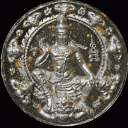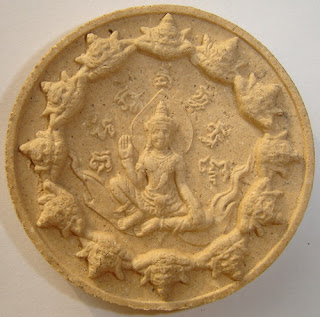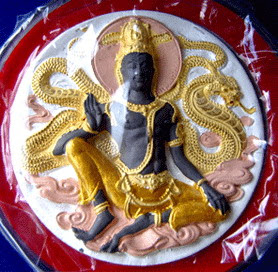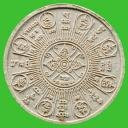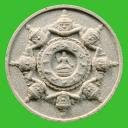Richard S. Ehrlich
BANGKOK, Thailand. Buddhists have become obsessed with a magic amulet which resembles a rap star's bling-sized medallion, despite warnings that the circular icon is a cosmic crutch, corrupting religion and society. When a fresh batch of Jatukam Ramathep amulets went on sale in April, buyers stampeded, trampling a woman to death. Thieves have infiltrated shops, homes and temples to steal the lucrative charm.
Jatukam amulet sales may have reached 500 million U.S. dollars during the past two years, according to economists, though estimates vary because many transactions are in cash, without receipts. "Jatukam is the most popular deity in Thailand today," reported The Nation newspaper, but experts disagree over who the amulet represents. Some insist Jatukam Ramathep are the names of two princely brothers who lived in this region hundreds of years ago.Others believe Jatukam Ramathep is one person, perhaps King Chandrabhanu, who ruled much of Southeast Asia during the ancient Srivijaya kingdom. Others insist the person on the amulet is a potential Buddha, or perhaps a Hindu deity.In the center of the cookie-sized amulet, a man in traditional regalia sits in a meditative pose, left hand on his knee, and right hand held shoulder-high, palm outward. Variations can include one or two dragons behind him, or a multi-headed serpent, or a surrounding ring of Hindu deities. Medallions come in red, white, black, silver or gold. The reverse side may show a man standing, or instead display a sun or moon emitting rays, or 12 cosmological signs.Frenzy over the amulets, and concern over the purity of Thailand's Buddhism, coincide with an ongoing public debate about how Buddhists should behave, and how much financial and political power the elderly, conservative, male, saffron-robed clergy should wield. "Many high-ranking [Buddhist] monks in Bangkok are astrologers, masters of the occult arts, or entrepreneurs in the amulet industry, making Thailand one of the world's largest amulet producers," wrote Mettanando Bhikku, a Thai Buddhist monk who criticizes contradictions within the religion.
The amulet market is controlled by the Buddhists' Ecclesiastical Council in Thailand, and allows temples to gain millions of dollars, tax-free, he said."Essentially, this is a worship of spirits," lamented The Bangkok Post's assistant editor Sanitsuda Ekachai. "The Jatukam Ramathep phenomenon does not only reflect public insecurity from political uncertainties and terrorism threats, it also shows that we are basically animists."If we really need a national religion, animism should be the one. At least it can help us stop fooling ourselves that we are still Buddhists, and see who we really are," she wrote. Thailand's Supreme Patriarch, who heads this country's Buddhist clergy, announced on Sunday (April 22) he will stop providing materials from his temple to make Jatukam amulets, but declined to specify why. His temple earlier provided sacred ash from burnt incense, colored powder from bricks used in temple construction, and other Buddhist-related material to make thousands of Jatukam amulets. The Supreme Patriarch's announcement came after thieves reportedly broke into a nearby Buddhist temple on Sunday (April 22) and stole 30 Jatukam amulets, valued at about 430 U.S. dollars.Earlier, robbers in the southern region broke through an amulet stall's ceiling and escaped with Jatukam amulets priced at 5,700 U.S. dollars. Most Jatukam amulets have been made with the blessing of Wat Phra Mahathat Woramahawiharn, the Supreme Patriarch's temple in southern Thailand's Nakhon Si Thammarat city. When the amulets' price recently soared, dealers throughout Thailand rushed to set up stalls next to the temple, hoping to get the newest versions.Crowds crushed a woman to death, and injured about 100 others, on April 9 when thousands of people ran toward a school in Nakhon Si Thammarat to buy the amulets. In the same town, during March, an amulet-collecting woman used her husband's 9-mm pistol to kill a man allegedly breaking into her home along with three other criminals, who fled into the night
Another amulet collector shot dead a suspected thief in the same southern town on March 26, police said. More than 90 percent of this nation's 65 million population believe in Buddhism, a religion which emphasizes freedom from superstition, gods, and other illusions. Many Thai Buddhists, however, collect and wear various amulets which also depict famous monks, kings and other people, living or dead."I am a Buddhist and I like the Jatukam amulets because I want more luck," said businessman Somsak Sacjew in an interview on Wednesday (April 25). Mr. Somsak, 35, was buying six of the amulets, for about 5.70 U.S. dollars each, in a Bangkok shopping mall. "I am going to give them to my son and daughter, 20 years from now. I think I have more than 50 Jatukam amulets now. I don't resell them," Mr. Somsak said."Most people request the Jatukam amulets because it is good for business, good for your family, and good for your life," said Hua Pongsak, an amulet shopkeeper offering a selection priced at 20 U.S. dollars to 72 U.S. dollars each. Kanita Shi, 35, said she recently bought a Jatukam amulet for 20 U.S. dollars from Mr. Hua's shop, because she wants good luck -- even though she believes Buddha protects her and already gives her lots of luck."It is like if you already have two million dollars. It is enough, but won't you then want four million dollars?" Ms. Kanita said in an interview at the shop. "I observed my life before I bought this amulet, and compared what happened after I bought it, and I saw my business became better and my family life became better," she said. Sculptors, who create a unique mold to cast the amulet in a clay-like material, can make hundreds of U.S. dollars by designing new versions.Printers are churning out color brochures, vinyl-covered posters, and other displays to advertise the amulets. Web sites, including Uamulet.com, offer the amulets online. Clothing vendors print Jatukam's portrait on T-shirts, while metalworkers produce the amulet as a thin bronze coin. Other profiteers include producers of raw materials to make the amulets, organizers of blessing rituals, and distributors.
Jatukam also appears on "incantation cloth" -- which is usually a rectangle of inexpensive cotton, illustrated with a wood-block printed image. Temples, raking in cash by manufacturing the amulets, pump the money into the local economy by hiring construction crews to build Buddhist shrines, stupas and schools. The first Jatukam amulet was reportedly made in Nakhon Si Thammarat in 1987, to raise funds for the city's shrine. Originally selling for about one or two U.S. dollars, those early medallions now list for 2,000 to 28,000 U.S. dollars.More than 100 versions of the Jatukam amulet now appear in shops throughout Thailand, and competition among sellers is fierce. Some versions include tempting names, such as the expensive "Arch-Millionaire" and "Money Pouring In" series.
Richard S Ehrlich is a Bangkok-based journalist who has reported news from Asia since 1978 and is co-author of "Hello My Big Big Honey!", a non-fiction book of investigative journalism. He received Columbia University's Graduate School of Journalism's Foreign Correspondents Award.
http://globalpolitician.com
Free Mozilla Firefox
30 June 2007
19 June 2007
Jatukam Wat Pailom
15 June 2007
07 June 2007
The facts behind the Jatukam Ramthep talisman nonsense
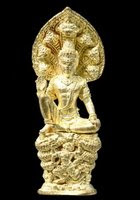
In the past month or so, several articles have appeared in the Thai and English media concerning the phenomenal popularity of a magical talisman, promising instant wealth to those who wear one.
The talisman features a divine being called Jatukam Ramathep, unknown in Buddhist or Hindu sacred literature. He seems to be the invention of a confused imagination, and most intelligent commentators condemn this new cult as indicating a corruption of both Buddhist morality and Thai animistic spirituality.
In order to understand the problem, we need to get the god's name right:
Jatukam Ramathep is the Thai pronunciation of the Pali Catugamaramadeva, meaning God Rama of the Four Villages. This is near nonsense as no ancient literature, Buddhist or Hindu, connects Rama to "Four Villages". Thus the name seems to have been created out of thin air.
However, the talisman is connected in the popular imagination to the Great Stupa of Nakhon Si Thammarat. According to respectable tradition preserved in an ancient document (see Wyatt, DK, "The Crystal Sands: The Chronicles of Nagara Sri Dharmmaraja", Cornell) the relics enshrined in the Great Stupa there came from Sri Lanka and the stupa was established with the assistance of traders from Sri Lanka, where Buddhism has always been protected by Hindu gods.
(The evidence is in the Mahavamsa and in folk religion to this day.)
Here is the evidence as far as I have been able to trace it from credible physical and documentary sources:
At the Great Stupa at Nakhon Si Thammarat, the stairs leading up to the circumambulatory terminate in a narrow stage with four images of gods. To the extreme left and right are two gods in brick and plaster with no attributes. However inscribed stone plaques (in apparently old lettering) announce that they are Lord Khattugama and Lord Ramadeva.
The door in the centre consists of two wooden leaves each carved with a deity in high relief. One is obviously Vishnu with his disc and conch, but he also holds a bow, indicating that he is the Rama incarnation.The other deity has four visible faces and so has been identified as Brahma, but he holds weapons (unlike Brahma who holds sacrificial implements).If one counts the invisible faces (at the back of the relief) one gets six. The six faces and the weapons indicate the god Skanda (known in Sri Lanka as Kataragama) who has six faces and holds all weapons as Commander of the Heavenly Forces.
A 16th century Pali chronicle (see Penth, H Jinakalamali Index, Pali Text Soc, 1994) tells the following tale: the King of Sukhothai had heard of the fame of a Buddha image in Sri Lanka and he desired to acquire it. He sent an emissary to the king of Nakhon Si Thammarat, who reported that Sri Lanka was invincible as it was protected by four gods, namely Khattugama, Rama, Lakkhana and Sumana.In Sri Lanka, today, popular tradition claims that the island is protected by four great deities, among whom are Kataragama (Khattugama in Pali) and Rama under the tittle Upulvan (the Blue God or Vishnu) but as he holds a bow we must suppose he is the Rama incarnation.
All this information may seem confusing to those unfamiliar with Hindu-Buddhist mythology and iconography, but from this respectable evidence we may construct a credible history.
In the late 12th century Sri Lankan Theravada Buddhism became established in mainland Southeast Asia together with its relics, footprints, Bodhi trees, texts and protective deities.
These were most faithfully recorded and remembered at Nakhon Si Thammarat. However in modern times, tradition has been forgotten. People lack knowledge of the texts to which I have referred. As a result they have confused the two guardian deities, Khattugama and Ramadeva, and conflated and corrupted their names, producing Jatukam Ramathep, a single deity without a historical background.
But who can blame the Thais?
I am reminded of a tale told (I think) by Evelyn Waugh. In Italy he once visited an obscure church that housed a splendid old woodcarving of St George on horseback killing the dragon. It was festooned with scraps of paper bearing prayers for wealth, health and success.
Waugh remonstrated with the parish priest about this gross idolatry.
The priest ruefully agreed and added that when the cultural authorities removed St George for restoration, leaving the horse, his parishioners wanted to attach their petitions to its tail and mane. "My flock don't worship St George," said the priest, "they worship the horse!"In like manner, it seems, many Thai Buddhists have forgotten the Buddha, his liberating teachings and the relics of his person, and instead devote themselves to a protective deity, and a spurious one at that.
Several distinguished Thai scholars have proposed that the Jatukam Ramathep phenomenon indicates a failure of Buddhism. I would prefer to avoid this conclusion as religions do not fail unless they become fossilised and obsolete (like classical paganism).
Rather, societies fail to remember and live up to the admirable principles of their religions.Indeed societies tend to pervert and demean their inherited wisdom.
In the case of the Jatukam Ramathep talisman here in Thailand, we have a society that counts greed and gain as the highest good, and an educational system that fails to provide access to Asian cultures. Nor does it make available to the public our most important historical texts.
If many Thais had read the relevant parts of the chronicles that I have quoted, then a nonsense deity like Jatukam Ramathep would never have been conceived.
Michael WrightSpecial to The Nation
The talisman features a divine being called Jatukam Ramathep, unknown in Buddhist or Hindu sacred literature. He seems to be the invention of a confused imagination, and most intelligent commentators condemn this new cult as indicating a corruption of both Buddhist morality and Thai animistic spirituality.
In order to understand the problem, we need to get the god's name right:
Jatukam Ramathep is the Thai pronunciation of the Pali Catugamaramadeva, meaning God Rama of the Four Villages. This is near nonsense as no ancient literature, Buddhist or Hindu, connects Rama to "Four Villages". Thus the name seems to have been created out of thin air.
However, the talisman is connected in the popular imagination to the Great Stupa of Nakhon Si Thammarat. According to respectable tradition preserved in an ancient document (see Wyatt, DK, "The Crystal Sands: The Chronicles of Nagara Sri Dharmmaraja", Cornell) the relics enshrined in the Great Stupa there came from Sri Lanka and the stupa was established with the assistance of traders from Sri Lanka, where Buddhism has always been protected by Hindu gods.
(The evidence is in the Mahavamsa and in folk religion to this day.)
Here is the evidence as far as I have been able to trace it from credible physical and documentary sources:
At the Great Stupa at Nakhon Si Thammarat, the stairs leading up to the circumambulatory terminate in a narrow stage with four images of gods. To the extreme left and right are two gods in brick and plaster with no attributes. However inscribed stone plaques (in apparently old lettering) announce that they are Lord Khattugama and Lord Ramadeva.
The door in the centre consists of two wooden leaves each carved with a deity in high relief. One is obviously Vishnu with his disc and conch, but he also holds a bow, indicating that he is the Rama incarnation.The other deity has four visible faces and so has been identified as Brahma, but he holds weapons (unlike Brahma who holds sacrificial implements).If one counts the invisible faces (at the back of the relief) one gets six. The six faces and the weapons indicate the god Skanda (known in Sri Lanka as Kataragama) who has six faces and holds all weapons as Commander of the Heavenly Forces.
A 16th century Pali chronicle (see Penth, H Jinakalamali Index, Pali Text Soc, 1994) tells the following tale: the King of Sukhothai had heard of the fame of a Buddha image in Sri Lanka and he desired to acquire it. He sent an emissary to the king of Nakhon Si Thammarat, who reported that Sri Lanka was invincible as it was protected by four gods, namely Khattugama, Rama, Lakkhana and Sumana.In Sri Lanka, today, popular tradition claims that the island is protected by four great deities, among whom are Kataragama (Khattugama in Pali) and Rama under the tittle Upulvan (the Blue God or Vishnu) but as he holds a bow we must suppose he is the Rama incarnation.
All this information may seem confusing to those unfamiliar with Hindu-Buddhist mythology and iconography, but from this respectable evidence we may construct a credible history.
In the late 12th century Sri Lankan Theravada Buddhism became established in mainland Southeast Asia together with its relics, footprints, Bodhi trees, texts and protective deities.
These were most faithfully recorded and remembered at Nakhon Si Thammarat. However in modern times, tradition has been forgotten. People lack knowledge of the texts to which I have referred. As a result they have confused the two guardian deities, Khattugama and Ramadeva, and conflated and corrupted their names, producing Jatukam Ramathep, a single deity without a historical background.
But who can blame the Thais?
I am reminded of a tale told (I think) by Evelyn Waugh. In Italy he once visited an obscure church that housed a splendid old woodcarving of St George on horseback killing the dragon. It was festooned with scraps of paper bearing prayers for wealth, health and success.
Waugh remonstrated with the parish priest about this gross idolatry.
The priest ruefully agreed and added that when the cultural authorities removed St George for restoration, leaving the horse, his parishioners wanted to attach their petitions to its tail and mane. "My flock don't worship St George," said the priest, "they worship the horse!"In like manner, it seems, many Thai Buddhists have forgotten the Buddha, his liberating teachings and the relics of his person, and instead devote themselves to a protective deity, and a spurious one at that.
Several distinguished Thai scholars have proposed that the Jatukam Ramathep phenomenon indicates a failure of Buddhism. I would prefer to avoid this conclusion as religions do not fail unless they become fossilised and obsolete (like classical paganism).
Rather, societies fail to remember and live up to the admirable principles of their religions.Indeed societies tend to pervert and demean their inherited wisdom.
In the case of the Jatukam Ramathep talisman here in Thailand, we have a society that counts greed and gain as the highest good, and an educational system that fails to provide access to Asian cultures. Nor does it make available to the public our most important historical texts.
If many Thais had read the relevant parts of the chronicles that I have quoted, then a nonsense deity like Jatukam Ramathep would never have been conceived.
Michael WrightSpecial to The Nation
A JEEP HIT BY A TRAIN, COUPLE SURVIVED, BELIEVED IN MIRACLE OF “JATUKAM RAMTHEP”

A JEEP HIT BY A TRAIN SURVIVED, BELIEVED IN MIRACLE OF “JATUKAM RAMTHEP”
A husband drove a jeep on their way back home, however they had gone in the middle of the train traffic light and was severely hit by the incoming train. The jeep was overturned but the couple was safe marking a little injury. The husband believed in the miracle of “Jatukam Ramthep” which he hangs to his neck and stated that it made them safe. On the 13th of May 2007, at 08.00 pm, Pol.Lt.Col. Jeewatphong Ruengdee, South Pattaya Investigator, Chonburi, reported an accident of a train hit a jeep including some people who got injured at Baan Tunggrad – Nongphangphuey road, Moo 4, Banglamung, Chonburi, then quicken to the incident with Sawang Boriboon Rescue. At the occurrence, a railway crossing road on Tunggrad - Nongphanphuey road, about 5 km., from the Sukhumvit Rd. They found an overturned white Suzuki jeep (Caribian), licensed 221, Chonburi, illustrating a severe damage. The rescuer found a married couple injured inside the car, then instantly moved them to Banglamung hospital. The wife, Miss Sasima Thongsuk, (31), living at 211/9, Moo 12, Tung Sukla, Sriracha, Chonburi, got wounded on the head, broken cut on the right leg, and a few scratches around the body. The husband, Mr. Phoonpol Nakornpakdi, (37), addressed at 136, Moo 2, Ta-bor, Nongkai province, has a less amount of scratches around his body.
Mr. Phoonpol stated that they came from Sattahip, taking his wife to visit her mother. On the way back, he used the short cut to go back home to Sahaphat residence in Sriracha. He made it at the railway-crossing road that didn’t have much light around. Noticing that the barrier was not so long, he decided to take the risk to pass the gap. While pressing the accelerator to pass across, his wife suddenly screamed seeing the incoming train. He was trying to reverse the jeep, but it was too late.
It was hit by 22 bogies train that carries gas from Bangkok to Rayong . The train harshly hit on the passenger’s side where the wife was sitting. The jeep was overturned and went straight to the grass field. The married couple got stuck but managed to get out, having a few bruises. According to the accident, the couple strongly believed that they were safe because of the safety given by “Jatukam Ramthep”, special image, generated by sport news association of Thailand. Mr. Phoonpol bought the image from a friend who is a newsman, to hang around his neck for support merit and protection
Khun Pantarakrachadej

The police general came a third time, and the second medium claimed to be yet another spirit - Jatukam, who instructed him to lead the construction of a city pillar. However, the spirit advised him that first he should consult with Police Maj Gen Khun Pantarakrachadej (also known as Ajarn Khun Phan), who was thought to be a master of Buddhist magical arts (Puttakom). This is believed by some to be the reason why Jatukam Ramathep was chosen to be a model for the amulet images when the campaign to raise funds for the city pillar was launched. The city pillar was partly completed in 1987, and the original Jatukam amulets were made in 1986. It was circular pendant a five-centimetres in diameter, and was priced at 49 baht. Now many are sold for more than 100,000 baht each. In the past only very few Jatukam amulets were produced, but after Police Maj Gen Khun Pantarakrachadej (Khun Phan) passed away recently at the age of 103 (some say 108), the amulets again became very popular. It may be significant that his death on Sep 5th 2006 was just two weeks before the military coup in Bangkok. Since the royal cremation ceremony of Khun Phan last February, Jatukam amulets have become even more popular. But how long can the craze last?
Wat Phra Mahathat
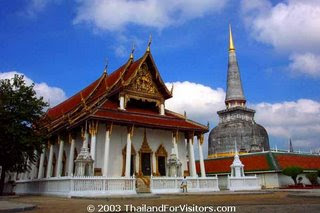
Wat Phra Mahathat temple is located on Ratchadamnoen Road in Tambon Nai Muang, Amphue Meuang of Nakhon Si Thammarat province. This is one of the most important historical sites in Southern Thailand. The stupa, 55.78m high, has a distinctive Sri Lankan style. The top of the spire is entirely covered in pure gold. Inside the temple are many buildings of importance, especially the royal building which has beautiful architecture from the Ayutthaya period and the Sam Chom building, where the Buddha image garbed in royal attire - Phra Si Thamma Sokarat is housed. There are also the Phra Maha Phinetkrom (the equestrian image) building and the Thap Kaset building; while the Khian and Pho Lanka buildings are used to display artifacts donated to the temple by Buddhists from the whole region.
Over the doorway at the entrance of Wat Phra Mahathat in Nakhon Si Thammarat, there are the statutes of Tao Kadtukam and Tao Ramathep, the guardian deities of holy relics of the Buddha. The name of one deity is Tao Kadtukam, which later people understand that he is none other than Jatukam.
There are many stories on how the City Pillar (Lak Meuang) and the first Jatukam amulets were made. One story tells of Police Maj Gen Sanpetch Thammikun, the provincial police chief during the 1980s, going to Wat Nang Phraya during a shamanistic ritual. The medium, a woman, told the policeman to come back. When he did come back later the woman wasn't there, but had been replaced by a new medium claiming to be the spirit of the military leader for the B.E. 17th century Nakhon Si Thammarat king.
There are many stories on how the City Pillar (Lak Meuang) and the first Jatukam amulets were made. One story tells of Police Maj Gen Sanpetch Thammikun, the provincial police chief during the 1980s, going to Wat Nang Phraya during a shamanistic ritual. The medium, a woman, told the policeman to come back. When he did come back later the woman wasn't there, but had been replaced by a new medium claiming to be the spirit of the military leader for the B.E. 17th century Nakhon Si Thammarat king.
The Legend of Jatukam Ramathep
Once upon a time, many centuries ago (about 1700 years ago), it was a time of war and trouble. There lived a king and his princes in Central Siam. The elder prince named Jatukam and the other named Ramathep. After many years of war, the King finally conquered and managed to secure Sri Lanka into part of his Kingdom. There was a saying that the King possessed a sacred treasure, this was none other than the holy relics of Lord Buddha. Before the King began his journey to the newly conquered land, he tasked the protection of the relics to his two princes, & ordered them to guard it with their lives.Some time later, the princes received information of plan by their enemies to capture the relics. They immediately informed the King in Sri Lanka. The King instruction was to quickly take the relics away by sea and head to Sri Lanka. Halfway through the journey, a thunderstorm struck and their ships were sunken. Except the two princes, the rest of the crew did not survive.The two princes were washed ashore, but well. Without the sea transport, they could no longer bring the relics to Sri Lanka. They started praying sincerely to the relics, saying: “Dear Enlightened One! If this land we step upon is a holy piece of land, then please guide us let us live a new life here. With our people, we shall guard and protected your relics forever.”Later the two princes built a temple on this holy land and with much hard work, they also establish a wealthy and strong city. They brought new hope and peace to all the people. In remembrance of the great deeds by the two princes, they named this place Nakhon Si Thammarat in their honour. This is now located at Southern of Thailand at the present time. The temple that the two princes built for the relics is called Wat Mahathat - as it is known now.Ever since then, after a few centuries, many people had travelled to Wat Mahathat to locate the relics that were buried by the princes. Finally, they found a stone carving and the relics buried at the Wat. The stories of the two princes were found engraved on this stone.The two princes had done many great deeds and the greatest is by erecting the temple to house the relics. And they promised to guard the Relics with their lives. They had earned respect from both the heavenly and earthly beings. Later, the people combined the two princes into one and named him Tao Jatukam Ramathep when praying to him. Tao Jatukam Ramathep becomes one of the most respected and popular deities in the South of Thailand. In olden days, Tao was used to address noble ones. It is believed that those that pray to Tao Jatukam Ramathep will be blessed with fulfilling life and better in all aspects in everyday work. (End)
Subscribe to:
Posts (Atom)

